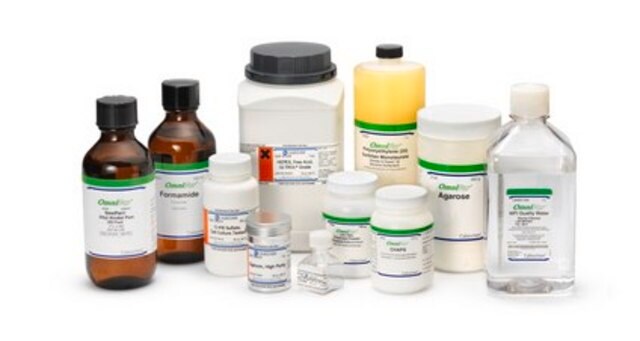A0701
Agarose, low gelling temperature
Type VII-A
Synonym(s):
2-Hydroxyethyl agarose
Sign Into View Organizational & Contract Pricing
All Photos(3)
About This Item
Recommended Products
type
Type VII-A
Quality Level
form
powder
technique(s)
electrophoresis: suitable
impurities
≤7% water
ash
≤0.4%
turbidity
≤4 NTU (1.5% gel)
EEO
≤0.12
mp
65 °C±1 °C
transition temp
gel point 26 °C ±2 °C (1.5% gel)
gel strength
≥250 g/cm2 (1% gel)
anion traces
sulfate (SO42-): ≤0.4%
Related Categories
General description
Agarose is a polymer extracted from agar or agar-bearing marine algae. This purified linear galactan hydrocolloid comprises alternating co-polymers D-galactose and 3,6-anhydro-L-galactopyranose units connected by α-(1→3) and β-(1→4) glycosidic bonds. Agarose is highly biocompatible due to its variable mechanical and diffusion properties.
Application
Excellent for in-gel enzymatic reactions and cloning assays and for recovery of heat-labile samples after electrophoresis
Agarose has been used:
Agarose has been used:
- to encapsulate Escherichia coli on a hydrogel in tissue culture
- to entrap Aliivibrio fischeri on a disposable card involved in designing of toxicity biosensors
- as a the dispersed phase of emulsion during preparation agar beads
Biochem/physiol Actions
Agarose can be used as a gelling agent, to separate nucleic acids electrophoretically because its gels have larger pore sizes than polyacrylamide gels at low concentrations. Unlike polyacrylamide, the consistency of the gels is more solid (but also less elastic) It is also employed to determine cross reaction in immunoelectrophoresis (IEP) and Ouchterlony (double diffusion) plates in which antibody-antigen precipitin lines are studied. Agarose is used to make gel plates or overlays for cells in tissue culture. In addition, it is also used to form a gel matrix (either beaded and/or crosslinked) which can be used in chromatographic separations.
Analysis Note
The following is a list of properties associated with our agaroses:
Sulfate content - used as an indicator of purity, since sulfate is the major ionic group present.
Gel strength - the force that must be applied to a gel to cause it to fracture.
Gel point - the temperature at which an aqueous agarose solution forms a gel as it cools. Agarose solutions exhibit hysteresis in the liquid-to-gel transition - that is, their gel point is not the same as their melting temperature.
Electroendosmosis (EEO) - a movement of liquid through the gel. Anionic groups in an agarose gel are affixed to the matrix and cannot move, but dissociable counter cations can migrate toward the cathode in the matrix, giving rise to EEO. Since electrophoretic movement of biopolymers is usually toward the anode, EEO can disrupt separations because of internal convection.
Sulfate content - used as an indicator of purity, since sulfate is the major ionic group present.
Gel strength - the force that must be applied to a gel to cause it to fracture.
Gel point - the temperature at which an aqueous agarose solution forms a gel as it cools. Agarose solutions exhibit hysteresis in the liquid-to-gel transition - that is, their gel point is not the same as their melting temperature.
Electroendosmosis (EEO) - a movement of liquid through the gel. Anionic groups in an agarose gel are affixed to the matrix and cannot move, but dissociable counter cations can migrate toward the cathode in the matrix, giving rise to EEO. Since electrophoretic movement of biopolymers is usually toward the anode, EEO can disrupt separations because of internal convection.
Storage Class Code
11 - Combustible Solids
WGK
WGK 3
Flash Point(F)
Not applicable
Flash Point(C)
Not applicable
Personal Protective Equipment
dust mask type N95 (US), Eyeshields, Gloves
Choose from one of the most recent versions:
Certificates of Analysis (COA)
Lot/Batch Number
Don't see the Right Version?
If you require a particular version, you can look up a specific certificate by the Lot or Batch number.
Already Own This Product?
Find documentation for the products that you have recently purchased in the Document Library.
Customers Also Viewed
Spencer S Gang et al.
PLoS pathogens, 13(10), e1006675-e1006675 (2017-10-11)
Parasitic nematodes infect over 1 billion people worldwide and cause some of the most common neglected tropical diseases. Despite their prevalence, our understanding of the biology of parasitic nematodes has been limited by the lack of tools for genetic intervention.
Mahmoud Affi et al.
Analytical and bioanalytical chemistry, 408(30), 8761-8770 (2016-04-05)
Water quality and water management are worldwide issues. The analysis of pollutants and in particular, heavy metals, is generally conducted by sensitive but expensive physicochemical methods. Other alternative methods of analysis, such as microbial biosensors, have been developed for their
Extracting cell stiffness from real-time deformability cytometry: theory and experiment
Mietke A, et al.
Biophysical Journal, 109(10), 2023-2036 (2015)
M Cecilia Cirio et al.
PloS one, 6(4), e18858-e18858 (2011-04-29)
In the vertebrate embryo, the kidney is derived from the intermediate mesoderm. The LIM-class homeobox transcription factor lhx1 is expressed early in the intermediate mesoderm and is one of the first genes to be expressed in the nephric mesenchyme. In
Peter M Eimon et al.
Nature communications, 9(1), 219-219 (2018-01-18)
Neurological drugs are often associated with serious side effects, yet drug screens typically focus only on efficacy. We demonstrate a novel paradigm utilizing high-throughput in vivo electrophysiology and brain activity patterns (BAPs). A platform with high sensitivity records local field potentials (LFPs)
Our team of scientists has experience in all areas of research including Life Science, Material Science, Chemical Synthesis, Chromatography, Analytical and many others.
Contact Technical Service
